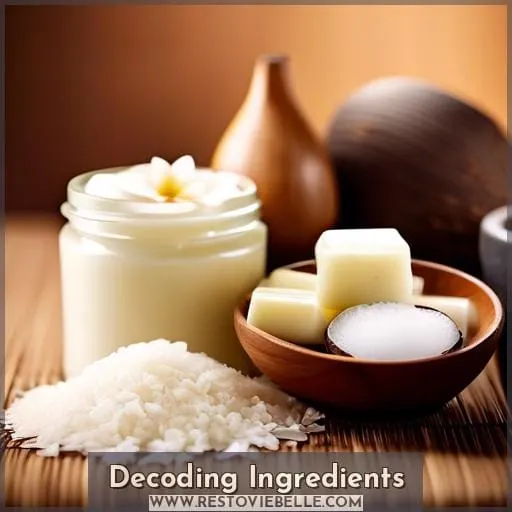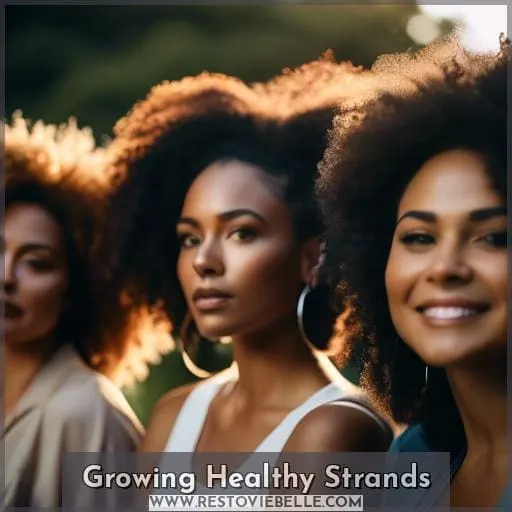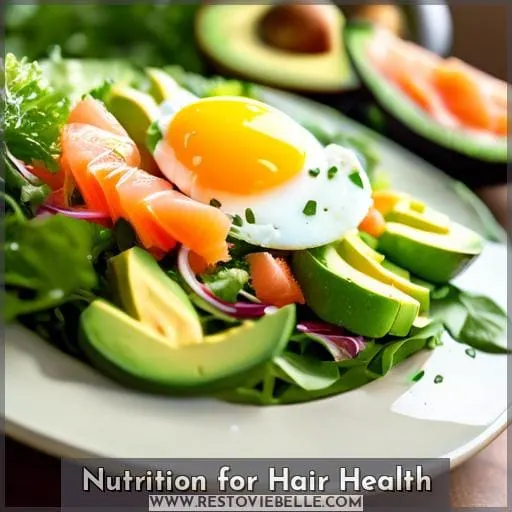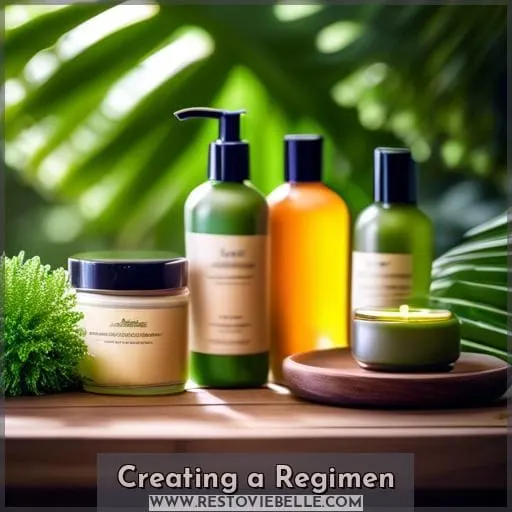This site is supported by our readers. We may earn a commission, at no cost to you, if you purchase through links.
 Embrace your natural curls and unlock their true beauty with these essential tips for healthy, radiant hair.
Embrace your natural curls and unlock their true beauty with these essential tips for healthy, radiant hair.
Discover your texture, porosity, and the perfect balance of moisture and protein to nourish your curls.
Table Of Contents
- Key Takeaways
- Dispelling Curl Myths
- Knowing Texture and Porosity
- Transitioning Tips
- Moisturizing Methods
- Balancing Protein and Moisture
- Decoding Ingredients
- Growing Healthy Strands
- Nutrition for Hair Health
- Choosing a Natural Salon
- Hashtag Search
- Consultation Availability
- Styling Process & Tools
- These discussion points highlight the importance of using hashtags to find natural hair salons
- asking about consultation options
- and understanding the styling process and tools used by the salon or stylist. These aspects are crucial for finding a suitable natural hair salon that aligns with your hair goals and preferences
- Creating a Regimen
- Frequently Asked Questions (FAQs)
- How can I maintain my natural hair while living in a dry climate?
- What are some common misconceptions about the impact of curl type on hair health?
- Are there any specific nutritional recommendations for promoting healthy natural hair growth?
- How can I identify a natural hair salon that specializes in caring for my specific hair texture and type?
- What are some lesser-known ingredients to look for in natural hair products, and what benefits do they offer?
- Conclusion
Key Takeaways
- Understand your hair’s unique characteristics: Recognizing your hair’s texture, porosity, and strand thickness is crucial for selecting the right products and establishing an effective care routine. This tailored approach ensures your hair receives the moisture and nutrients it needs, enhancing its natural beauty and health.
- Embrace protective styles and proper moisturizing techniques: Protective styles, such as twists and braids, safeguard your hair during the transition to natural hair, minimizing damage. Hydration is key, with water-based moisturizers for hydration and oils to seal in moisture. Regular deep conditioning further nourishes your hair, promoting its overall well-being.
- Balance protein and moisture for optimal hair health: Maintaining a harmonious balance between protein treatments and hydration is essential for strong, resilient curls. Assess your hair’s elasticity to determine its needs, and avoid over-manipulation and excessive styling to prevent breakage and maintain moisture levels.
- Transitioning requires patience and the right care: Transitioning to natural hair is a journey that demands time, patience, and the right care regimen. Utilize satin accessories to protect your hair from friction and damage, and allocate more time for hair care to ensure a smooth transition and the preservation of your hair’s health and beauty.
Dispelling Curl Myths
Dispelling Curl Myths: Not all curls are the same, and healthy curls aren’t a myth. It’s time to unravel the tangle of misconceptions surrounding curly hair. You’ve likely heard that curls only need conditioning, but regular shampooing is crucial to remove buildup and maintain scalp health.
Tangles can be daunting, yet with patience and the right products, detangling becomes a manageable task. And while it’s true that curly hair can be prone to dryness, it’s not immune to damage from heat and chemicals—protection is key.
Shrinkage might suggest slower growth, but your curls are growing at a steady pace; they’re just springing up to their natural resilience. Brushing wet curls is a styling fallacy; instead, a wide-tooth comb preserves your hair’s natural texture and minimizes breakage.
Remember, hair health isn’t dictated by curl pattern. Embrace your unique texture, and with the right hydration myths debunked and elasticity misunderstandings cleared, you’ll be on your way to flourishing natural hair styles and using hair products that truly benefit your hair health.
Knowing Texture and Porosity
Understanding your hair’s texture and porosity is crucial for tailoring your hair care routine to your specific needs. You’ll find that certain products and treatments will work better for you once you’ve identified these characteristics.
Hair classification helps in recognizing your natural hair types, while porosity testing reveals how well your strands absorb and retain moisture. Knowing the thickness of your strands can guide you in selecting the right products for conditioning natural hair.
The absorption rate is key to understanding how your hair interacts with moisture and products. Implementing hydration techniques suited to your hair’s porosity will enhance your natural hair care routine, ensuring your locks are well-nourished and vibrant.
Embrace these insights for a transformative approach to managing and loving your natural tresses.
Transitioning Tips
When you’re transitioning to natural hair, it’s essential to embrace protective styles and allocate more time for hair care.
Protective styles, such as braids or twists, safeguard your delicate new growth and help prevent breakage.
As you nurture your natural texture, remember that this journey requires patience and consistency, so be prepared to invest extra time into your hair regimen.
Protective Styles Help
Your transition gets easier with protective styles that nurture strands under tension.
- Satin accessories protect against friction and heat damage, ensuring your scalp health and length retention flourish.
- Natural hair styles like twists and braids minimize hair damage, promoting stronger, healthier hair.
- Hair accessories add flair while aiding in natural hair maintenance and protection.
More Time Needed
Transitioning to natural hair requires a significant investment of your time, as you’ll need to develop new routines and learn to care for your hair’s changing texture.
Embrace this journey with goal setting and journal keeping to track progress. Adjust your mindset to celebrate each milestone.
Experiment with products and reflect on styling choices. Incorporating deep conditioners can combat hair loss and promote growth.
Moisturizing Methods
To keep your natural curls healthy and moisturized, remember these essential tips:
- Water is the key to hydration, so use water-based moisturizers daily. Look for products with water listed as the first ingredient.
- Oils don’t moisturize; they seal in moisture. Apply a lightweight, natural oil like coconut or avocado oil after moisturizing to lock in hydration.
- Deep condition regularly to nourish your hair with moisture and nutrients. Aim for every two weeks, and use heat to enhance penetration for low porosity hair.
For a more detailed routine, consider the LOC or LCO methods, which involve layering leave-in, oil, and cream (or cream, oil, and leave-in) to lock in moisture and prevent dryness.
Oils Don’t Moisturize
One common misconception:
Oils like coconut, argan, and shea butter do not hydrate hair.
Instead, they serve a different purpose:
- Sealing hydration
- Locking in water after moisturizing
To maximize benefits:
- Apply oils after moisturizing
Additional uses of oils:
- Pre-poo treatment to protect strands
- Promote scalp health, especially for beginners nurturing natural hair
Reference(s):
- One common misconception is that oils can hydrate your hair, but in reality, they serve a different purpose in your hair care routine. [Original input]
- To maximize benefits, apply oils after moisturizing to lock in water. [Original input]
- Pre-poo with oils can also protect strands and promote scalp health, essential for beginners nurturing natural hair. [Original input]
Deep Condition Regularly
By deep conditioning your hair regularly, you’re able to provide much-needed hydration that keeps strands healthy and strong. This practice is crucial for maintaining the balance between moisture and protein within your hair, ensuring it remains resilient against breakage and damage.
When selecting a deep conditioner, opt for products tailored to your hair’s specific needs, considering factors like porosity and texture. Application techniques matter too; applying heat can enhance the treatment’s effectiveness by opening the hair cuticle, allowing deeper penetration of the conditioner.
Frequency considerations are key—very dry or damaged hair may benefit from weekly sessions, while healthier hair might only need bi-weekly treatments. Remember, using a sulfate-free shampoo and a rinse-out conditioner can prepare your hair for this vital step, and following up with a leave-in conditioner can seal in the moisture, promoting lasting hydration and strength.
Balancing Protein and Moisture
Equilibrium in hair care is crucial, and you’ll find that maintaining a harmonious protein-moisture balance is essential for the health and resilience of your curls.
- Apply a protein treatment weekly or bi-weekly to strengthen strands.
- Assess hair elasticity through a strand test and note if extra protein or moisture is needed.
- Prevent breakage by not over-manipulating brittle hair and protective styling.
- Ensure proper hydration techniques, like deep conditioning and leave-ins to avoid dryness.
Decoding Ingredients
To ensure the health and vitality of your curls, it’s essential to decode the ingredients in your hair care products. Recognize ingredient functions: moisturizers like aloe vera, strengtheners such as protein, and sealants like shea butter.
Be vigilant for allergy warnings; even natural elements like tea tree oil can provoke reactions. Seek vegan options if they align with your ethics, ensuring products are cruelty-free and plant-based.
pH balance is crucial; a slightly acidic environment helps seal cuticles, enhancing shine and reducing frizz. Consider the environmental impact of your choices—opt for biodegradable ingredients that don’t harm aquatic life.
Ylang ylang, for instance, not only promotes hair strength but is also eco-friendly.
Growing Healthy Strands
Building on the insights about ingredient benefits, let’s turn our focus to fostering healthy hair growth, which hinges on a well-rounded approach to hair care and overall wellness. You’ll want to ensure you’re not just feeding your hair with the right products, but also nourishing it from within with a balanced diet and proper hydration.
Scalp health is paramount; a clean, stimulated scalp promotes hair growth. Be mindful of genetic factors that influence your hair’s behavior and growth rate.
Stress can wreak havoc, so incorporate stress-reduction techniques into your routine. Lastly, protect your locks from harsh environmental effects with suitable products and styles, ensuring your journey to luscious curls is as smooth as possible.
Nutrition for Hair Health
As you nurture your hair from the outside, don’t forget the powerhouse of growth and vitality that comes from within.
Incorporate plenty of dietary fiber into your meals; it aids digestion and helps your body flush out toxins that could otherwise impact your scalp’s health.
Reach for vibrant antioxidant sources like berries, nuts, and leafy greens. These superfoods combat oxidative stress, which can prematurely age your hair.
Choosing a Natural Salon
When looking for a natural hair salon, it’s essential to use social media hashtags to discover salons that specialize in your hair type.
Don’t hesitate to ask about consultations; a good stylist will offer this to understand your hair goals and needs.
Pay close attention to the styling process and tools they use to ensure they align with maintaining the health and beauty of your curls.
Hashtag Search
Using specific hashtags on social media platforms can be a powerful tool in your search for a natural hair salon that meets your needs.
Popular hashtags like #NaturalHairSalon, #CurlyHairStylist, and #HealthyCurls can lead you to salons with social engagement, community support, and influencer insights.
Look for salons with brand partnerships and positive reviews, as these indicate a commitment to understanding and empowering diverse hair textures.
Consultation Availability
Following from the importance of using hashtags to identify potential salons, it’s essential to inquire about consultation availability when choosing a natural salon.
Ensure they offer Online Booking for seamless scheduling.
Check if Virtual Services are provided for preliminary advice.
Read Salon Reviews to gauge the quality of Personalized Care.
Expert Advice during a consultation can set the foundation for your hair’s liberation and empowerment.
Styling Process & Tools
The styling techniques and tools a natural hair salon employs reveal their commitment to healthy hair care.
- Edge groomer for sleek, defined edges without damage.
- Flexi rods for bouncy, defined curls without harsh heat.
- Denman brush for detangling and curl definition without breakage.
- Bobby pins for secure, protective styles without tension.
- Satin bonnet for overnight protection, keeping your curls moisturized and intact.
Choose a salon that prioritizes your hair’s health and uses tools that align with your desire for liberation, understanding, and empowerment in your natural hair journey.
These discussion points highlight the importance of using hashtags to find natural hair salons
In transitioning from discussing the styling process and tools, how can leveraging hashtags significantly streamline your search for the perfect natural hair salon?
By using specific hashtags related to natural hair and salons, you’re able to narrow down your options to those most relevant to your needs, making it easier to find a salon that specializes in the type of care and style you’re seeking.
Social media platforms become your ally in this quest, with salon reviews and community recommendations just a hashtag away.
Geographic targeting ensures you find local experts, while cultural expertise is often showcased, connecting you with stylists who understand your hair’s unique needs.
asking about consultation options
Every salon visit should begin with a comprehensive consultation. This crucial service ensures that any potential stylist provides a thorough hair analysis, discusses scalp health, and suggests custom regimens tailored to your curls.
Expect clear styling advice and thoughtful product selection to nurture your natural hair journey towards empowerment and healthy, beautiful curls.
and understanding the styling process and tools used by the salon or stylist. These aspects are crucial for finding a suitable natural hair salon that aligns with your hair goals and preferences
Understanding the styling process and tools used by your salon or stylist is a key step in ensuring their services align with your hair care goals and preferences. When transitioning from the topic of consultations, it’s important to delve into the specifics of how your hair will be handled during appointments.
- Salon Certification: Verify their expertise in natural hair care.
- Tool Sanitization: Ensures a hygienic environment for your hair.
- Stylist Experience: Look for a stylist with a proven track record.
- Appointment Scheduling: Flexible scheduling can accommodate your routine.
This knowledge empowers you to make informed decisions and maintain the integrity of your natural hair journey.
Creating a Regimen
After exploring the various aspects of choosing a natural salon, it’s time to focus on creating a regimen that aligns with your hair’s needs and your lifestyle.
Begin with seasonal adjustments; your hair may crave more moisture in winter and lighter hydration in summer.
Prioritize scalp health by incorporating regular cleansing and massages to promote circulation.
Embrace gentle styling practices to minimize breakage and maintain hair integrity.
Don’t overlook the importance of hair trimming to prevent split ends and encourage growth.
Finally, master hydration techniques, alternating between deep conditioning and protein treatments to maintain a healthy moisture-protein balance.
This tailored approach will keep your curls thriving.
Frequently Asked Questions (FAQs)
How can I maintain my natural hair while living in a dry climate?
In a dry climate, it’s crucial to lock in moisture. Start by washing your hair weekly with a hydrating shampoo and follow up with a deep conditioner.
Daily, spritz your hair with water or a leave-in conditioner to maintain hydration.
Avoid products with glycerin high in the ingredient list, as they can draw moisture out of your hair in dry environments.
What are some common misconceptions about the impact of curl type on hair health?
Looser curls do not necessarily indicate healthier hair. Hair health is determined by how you nurture your strands, not by curl type.
Curl type and hair health:
- Looser curls do not dictate hair health.
- Hair health is influenced by proper care and nourishment.
Conclusion:
- Curl type is independent of hair health.
- Focus on proper hair care for healthier strands.
Reference:
- Original text provided by the user.
Are there any specific nutritional recommendations for promoting healthy natural hair growth?
To boost natural hair growth, focus on a balanced diet rich in the following nutrients:
- Protein: Eggs and fatty fish like salmon, herring, and mackerel are excellent sources of protein, which supports hair growth.
- Iron: Iron-rich foods include red meat, poultry, fish, beans, lentils, tofu, fortified cereals, and spinach. Iron is necessary for oxygen delivery to hair follicles.
- Vitamins A, C, D, and E: These vitamins play essential roles in hair health and growth.
- Biotin: Found in eggs, spinach, and other plant foods, biotin is crucial for the production of keratin, a protein in hair.
- Zinc: Zinc helps keep hair follicles healthy and can be found in foods like sunflower seeds, salmon, and Greek yogurt.
- Selenium: Selenium supports hair growth and can be found in foods like Brazil nuts and fish.
Avoid deficiencies in these nutrients, as they can contribute to hair loss. If necessary, consult a healthcare provider about supplements like iron or biotin.
How can I identify a natural hair salon that specializes in caring for my specific hair texture and type?
To find a natural hair salon that caters to your specific texture and type, it’s beneficial to seek recommendations from individuals with similar hair.
Research online reviews and portfolios to ensure the salon has experience and expertise in caring for your unique hair.
What are some lesser-known ingredients to look for in natural hair products, and what benefits do they offer?
Look for exotic ingredients like baobab oil for elasticity. Aloe vera is great for moisture.
Conclusion
Embrace the journey to luscious, natural hair by cherishing every curl and kink. With the right knowledge of texture, porosity, and the delicate balance between moisture and protein, you’re set to flourish.
Stay curious, decode ingredients, and nourish from within.
Your natural hair 101 adventure awaits—radiant, healthy curls aren’t just a dream, but a reality you can achieve.















